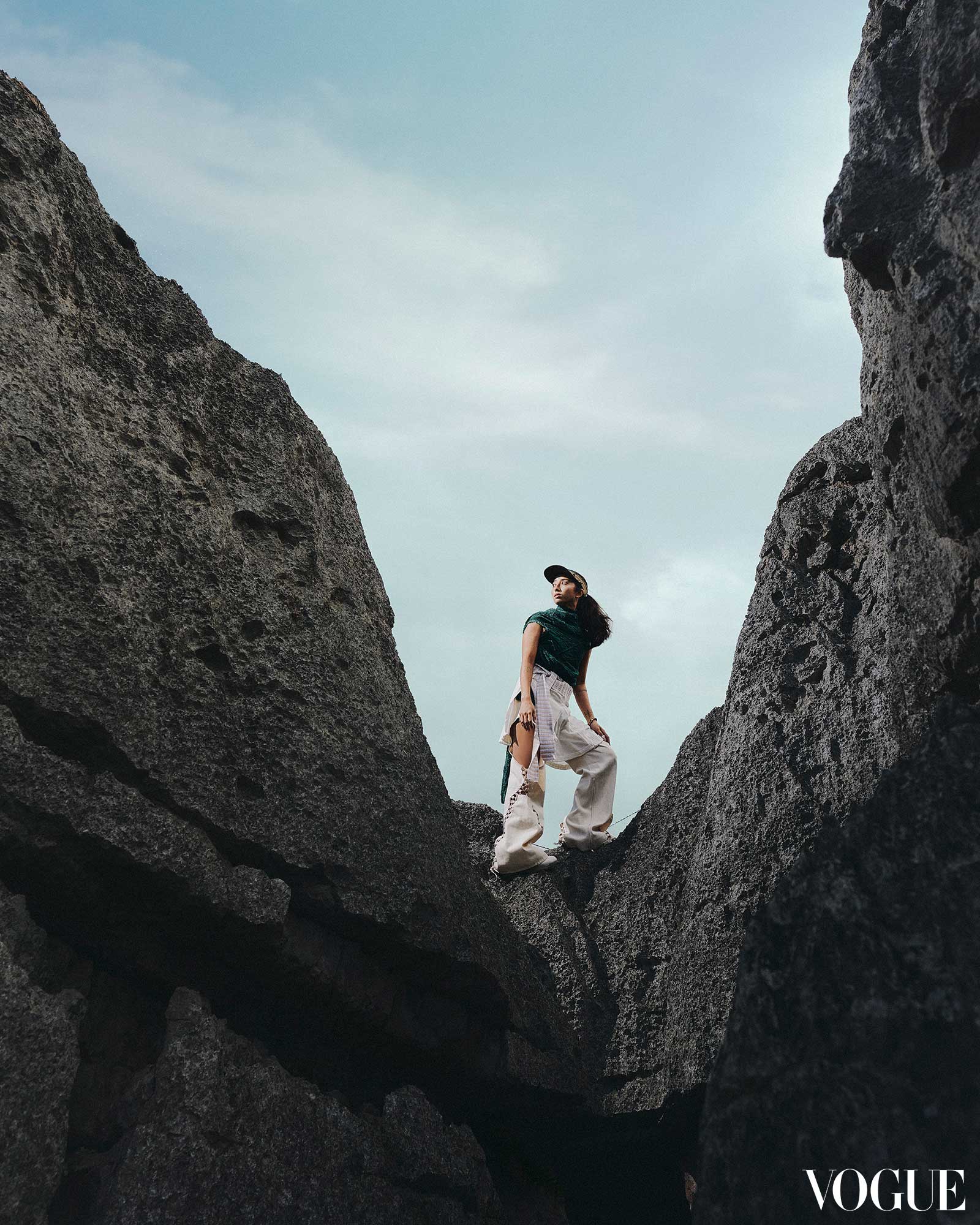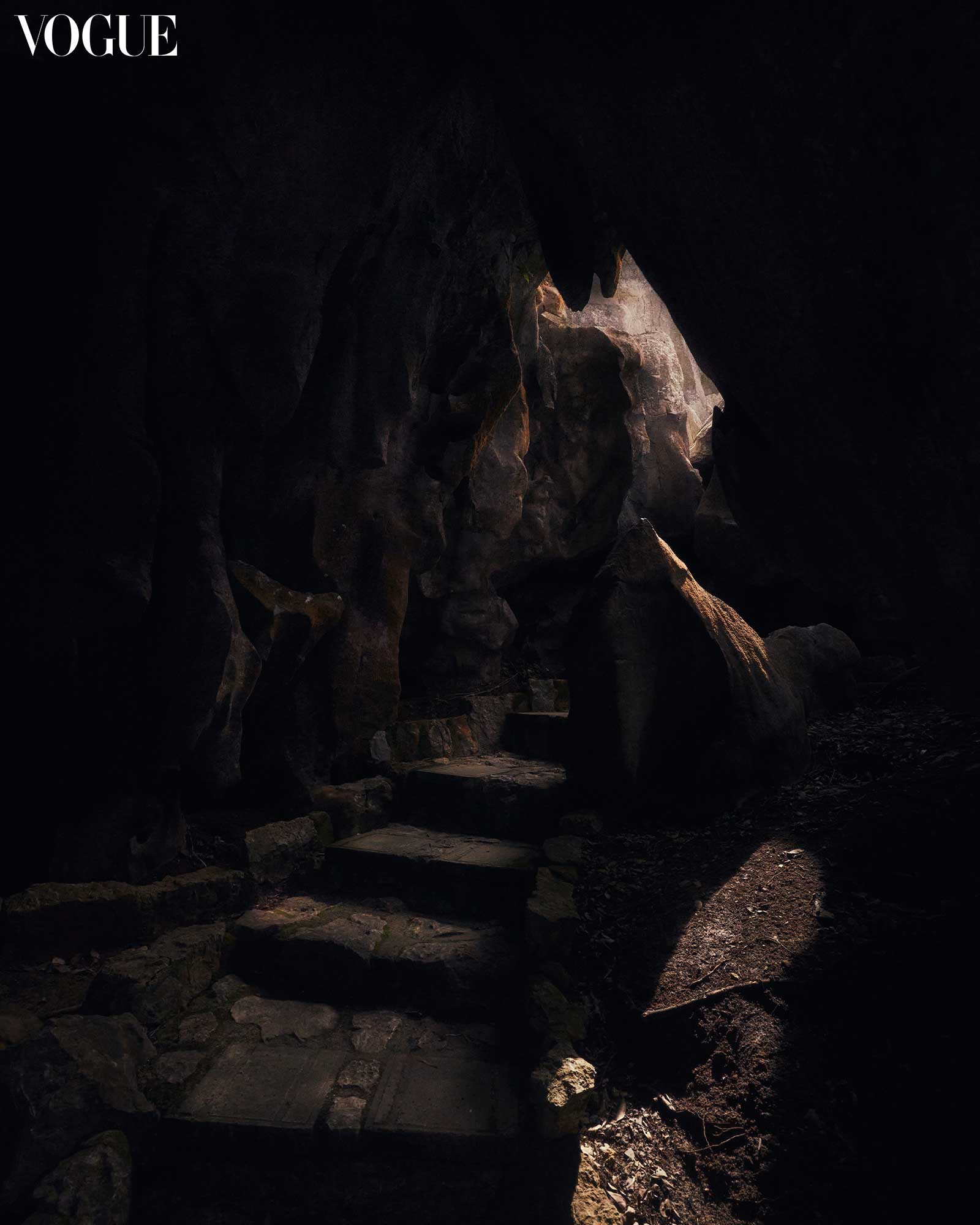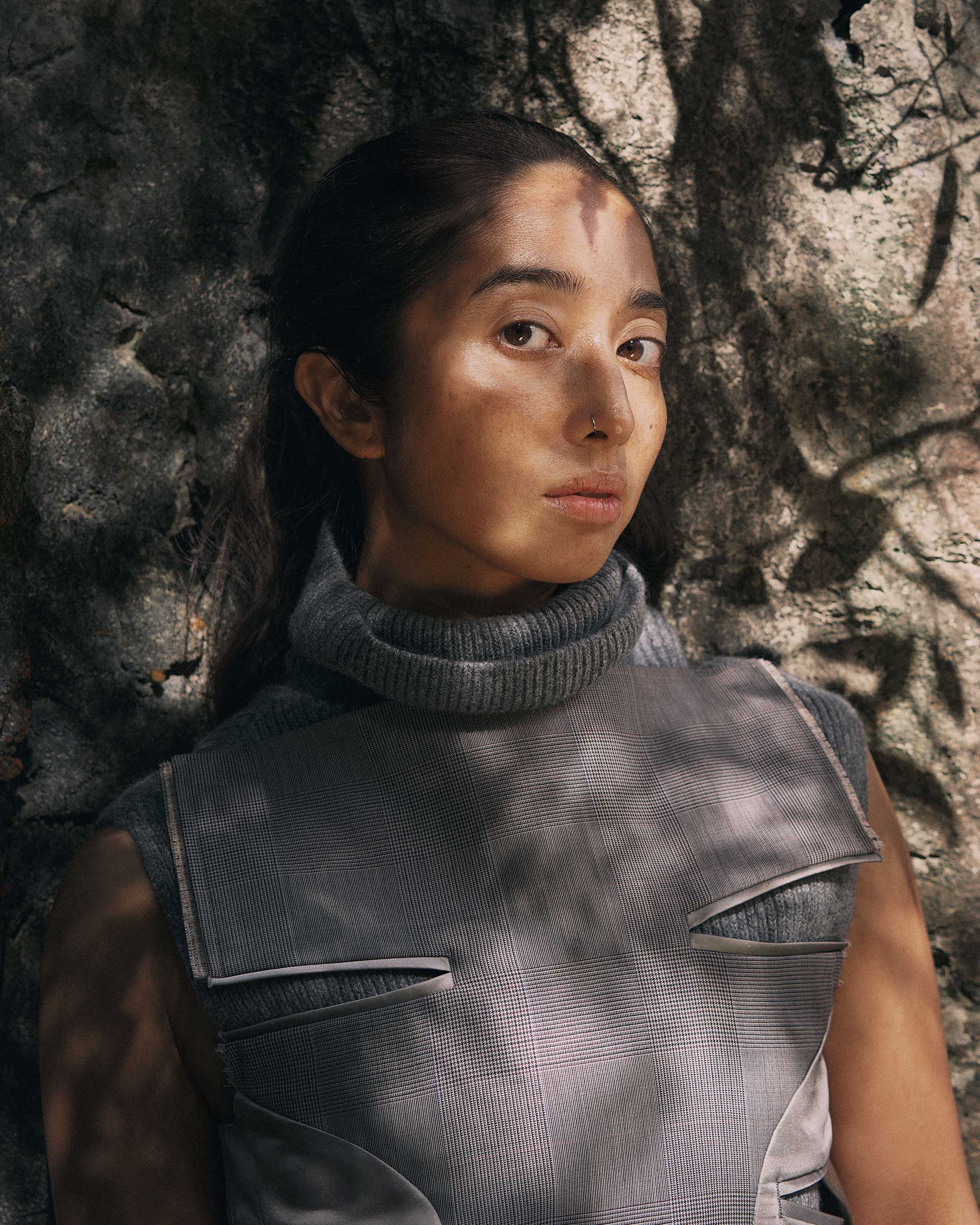SACAI cut-out satin dress, stylist’s own turtleneck. Photographed by Artu Nepomuceno for the February 2024 Issue of Vogue Philippines
As a surfer, Nicola Sebastian spent time immersed in the ocean. But only until a powerful typhoon made landfall did she consider what it meant to call an island home.
In the aftermath of supertyphoon Haiyan, Nicola Sebastian found herself on a beach in Eastern Samar, one that was previously known as Jagnaya Beach before it was renamed Yolanda, after the deadly storm surge of 2013 rearranged its landscape. She went there in the wake of a breakup, wanting to understand and bear witness to how people piece themselves together after such devastating loss. “I was unsure if people would want to talk about their traumas, but really the stories poured out,” she says. Listening to the stories of Yolanda survivors, reading historical texts on Samar, she found herself asking a different kind of question: How does the geography of the Philippine islands shape how Filipinos relate to ourselves, to each other, and to the world? This was the starting point of Nicola’s emergence as a writer grounded in ecology, and more specifically, islandness—an approach to thinking and creating that is informed by the archipelago.
Years later, when the global pandemic forced the world into lockdown, Nicola would meet three friends from different creative practices who had all happened to shelter in place in the surftown of San Juan in La Union: photographer Hannah Reyes Morales, independent curator David Loughran, and communications strategist Samantha Zarandin. The four of them co-founded Emerging Islands, a coastal-based arts organization and residency whose activities are developed from the framework of archipelagic thinking. “Emerging Islands is the applied part of our creative practices, where we’re not just writing about ideas and championing ecological stories, we’re trying to help build up a baseline ecological awareness by connecting communities and artists and scientists together,” Nicola explains.

Residents and collaborators have included British conservation photographer Mandy Barker, seaman-turned-painter Joar Songcuya, and Brussels-based performance artist Joshua Serafin. Last December, Emerging Islands transformed Mebuyan’s Vessel, the many-boobed alien space pod art installation of Leeroy New, into a queer island rave co-hosted by Elephant and Manila Community Radio. “It wasn’t just a party,” Nicola says, “it was about queer spacemaking in a more holistic sense. Northern Luzon Pride [an LGBTQIA+ organization] set such a powerful example of what it means to organize and resist in a region where queer and progressive politics are a tenuous, even dangerous position to take up.” The first day was devoted to dialogue where the collaborators dove into what it means to grow community from the ground up, and how to think of creativity as an ecosystem and as a communal act. The musical lineup of the second day was “transcendent,” as Nicola describes, with drag performances and dance music that wove Pinoy hip hop, budots, and other genres into transgressive new forms.
Climate justice is also queer justice, and Nicola is exploring this intersection through in a community storytelling project with the Talaandig and Manobo groups of Bukidnon, who are stewards of some of the last old-growth forests in the Philippines. Spending time in the forest with the Kulahi Performing Arts group whose members include queer and trans individuals who are also baylan (shamans or healers), Nicola came to realize that that queer spirituality is “deeply connected to the abundance of the Philippines. It’s the meeting place of the life and language of the Philippines.” Titled The Forests Speak, Their Spirits Cry, the film and book document the indigenous ancestral knowledge that has protected the sacred forests for centuries. “The project has also been a convergence of many different storytellers coming to support these storytellers, and I think that’s what we have to see happen more, where we’re taking the lead from communities at the frontlines.”
Nicola says she doesn’t necessarily think of herself as a climate worker, because she believes it’s a cause that shouldn’t just be relegated to activists or environmentalists, but something everyone has to get involved in in their own way. “There’s a lot of talent and abilities and experiences that people can bring to responding to this crisis. I hope to see unexpected collaborations, surprising solutions or innovations in responding—not even fixing, but just responding to it.” And where should people start? “I honestly think it comes from just loving the country, getting to know the cultures of the communities,” she says. “There’s so much beauty and abundance and wisdom in the diversity of our islands. The awakening to this climate awareness and developing a practice around supporting the changes we need to make—that comes from a place of love.”

From riding waves to creating change
If there’s anything to know about Nicola, it’s the fact that she loves exploring and understanding the world. Perhaps this is a result of her multicultural upbringing, having grown up in Hong Kong, studied in the United States, and lived in the Philippines. During summers and Christmases, she would spend her time at her family’s farms in the Philippines eating fruit, playing the river, and sailing paper boats. Here in the Philippines, she learned how to drive for the first time, an impressive feat as she learned the skill through driving a jeepney.
While she grew up switching between Hong Kong and the Philippines, Nicola has always been immersed in Filipino culture. But it wasn’t until she began surfing that she felt connected to the motherland.
“I’ve always loved the ocean. It became something that I centered my work and life around. I connected to my culture through surfing, and it grew from there,” she shares. “I love how it made me fall in love with the Philippines because I was coming at it from my terms, not by those set by who I am and where it comes from.”
Nicola found her voice in writing while exploring the ocean and seas. “I’ve always been scared to write. I always thought, ‘Oh, I have nothing to say. I’m just a kid.’ What do I have to say about anything?” she shares. Eventually, she realized that her passion lies in exploration. “I’m always driven to connect to the world and what was happening there.”
Through riding the waves, Nicola learned more about the ocean. “The Philippines is a gateway between the South China Sea, the West Philippines Sea, the Pacific Ocean, and the Indian Ocean. This is why there is so much marine biodiversity in our waters. It also creates this intersection and gateway between different cultures,” she says.

She also shares how the experience caused a shift in her writing. “It shifted from writing essays to exploring the wide cultural diversity of the Philippines and how the movements of life and language echo the islands themselves,” she says.
She continues, “What I do as a writer and a cultural worker at Emerging Islands is to grow stories. To find and connect the stories in ways that give hope, that grows not just understanding the Philippines, but also what can we do about it?”
Nicola learned more about indigenous communities through her work at Emerging Islands. “When I discovered the power and the relevancy of this issue of indigenous communities fighting for their homelands, sheltering biodiversity and storing carbon, I thought, ‘We need to address this alarming situation of the climate crisis,’” she shares.
For her, climate crisis should be a priority for everyone. “The idea of working on climate issues shouldn’t be a niche. We should all be thinking about it, especially with the Philippines being on the [environmental] frontline,” she says. “This is meant to be the issue, and everything we’re doing should be preparing and thinking about how we can make our communities more responsive, more resilient. Not as a celebration of Philippine resilience, but in the sense that how do we develop our disaster response mechanisms? What stories do we need to tell to get more people to think about this?”
In the future, Nicola hopes there will be more collaboration to combat these issues. “We should open our sphere of influence and change it up to make it more porous with different spheres and communities and allow mingling; maybe we can help yield new insights, new solutions, new stories that we write, tell, and create as a country.”
By Audrey Carpio. Additional text by Daphne Sagun. Photographs by Artu Nepomuceno. Fashion Director: Pam Quiñones. Beauty Editor: Joyce Oreña. Stylists: Renee de Guzman, Roko Arceo. Makeup: Angeline Dela Cruz. Hair: JA Feliciano, Mong Amado. Talents: Ann Dumaliang, Bella Tanjutco, Billie Dumaliang, Camille Rivera, Issa Barte, Nicola Sebastian, Tasha Tanjutco. Art Director: Jann Pascua. Producers: Anz Hizon, Bianca Zaragoza. Multimedia Artist: Gabbi Constantino. Production Assistant: Bianca Custodio, Patricia Co, Patricia Villoria, Tinkerbell Poblete. Photographer’s Assistants: Aaron Carlos, Choi Narciso, Mark Tijano, Odan Juan, Sela Gonzales, Rojan Maguyon. Stylist’s Assistants: Giselle Barnachea, Neil De Guzman, Ticia Almazan. Makeup Assistant: Jian Santos. Hair Assistants: Kyle Denzel Celis, Marjorie Caballos. Shot on location at Masungi Georeserve.
- Issa Barte On Amplifying Indigenous Voices And The Role Of Culture In Climate Action
- A Lifetime Of Growing And Protecting Forests: Ann And Billie Dumaliang On Their Ongoing Battle For Conservation At Masungi Georeserve
- Creativity As Catalyst: TAYO Philippines Founders Tasha and Bella Tanjutco On Using Creative Solutions For Climate Work
- Camille Rivera On Bringing Life Back To Communities Through Mangrove Conservation

